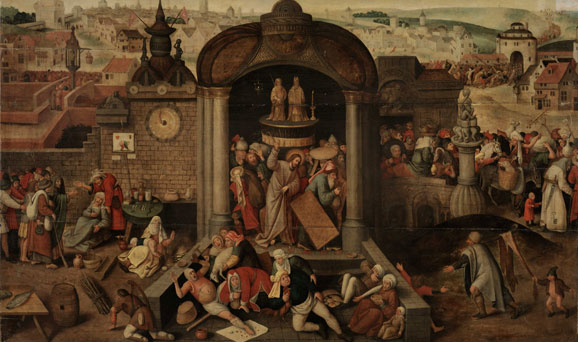Copenhagen - the provenance story
 The Copenhagen painting was acquired by the New Carlsberg Foundation on behalf of the National Gallery of Denmark in 1931. It was bought at Galerie Matthiesen, a private art dealership in Berlin, for the equivalent of 54,000 Danish crowns, and officially entered the National Gallery of Denmark’s collection in 1932. Prior to the sale the painting was in a private collection, and was exhibited in Antwerp, Belgium, in 1930.
The Copenhagen painting was acquired by the New Carlsberg Foundation on behalf of the National Gallery of Denmark in 1931. It was bought at Galerie Matthiesen, a private art dealership in Berlin, for the equivalent of 54,000 Danish crowns, and officially entered the National Gallery of Denmark’s collection in 1932. Prior to the sale the painting was in a private collection, and was exhibited in Antwerp, Belgium, in 1930.
 A label on the reverse of the painting printed with Galerie Matthiesen’s details reveals that at the time of the sale the painting was attributed to Hieronymus Bosch [fig.1 - The lower, earlier label (c.1930-1)].
A label on the reverse of the painting printed with Galerie Matthiesen’s details reveals that at the time of the sale the painting was attributed to Hieronymus Bosch [fig.1 - The lower, earlier label (c.1930-1)].
However, in 1932 the newly acquired painting was discussed in more depth in an article in the annual Kunstmuseets Aarsskrift by Max J. Friedländer, a German art historian and connoisseur, who argued vehemently for its reattribution to Pieter Bruegel the Elder.[1] The reattribution of the painting is in evidence in the form of another historic paper label attached to the back of the painting, reading “Breughel…”, which was pasted over the earlier label [fig.2 -The upper, later label (1932 or after)].
Interestingly, the Glasgow and Private versions of the composition are both referenced and illustrated in the 1932 article, but Friedländer does not seem to have been aware of the Tallinn painting at this time.[2]
 According to Friedländer, who based his judgment on the appearance of the work and his own connoisseurship, the artwork was painted by Bruegel around 1556.[3]
According to Friedländer, who based his judgment on the appearance of the work and his own connoisseurship, the artwork was painted by Bruegel around 1556.[3]
Although this attribution and date was accepted by experts at the time, subsequent scholars have rejected it.[4] Indeed, recent dendrochronology has shown that such an early date is not possible, and that the painting could not have been executed before 1562. Friedländer argued that the Copenhagen painting had little to do with Bosch himself in terms of either the painting technique or the palette – subsequent scholars can at least agree with him on this! Nowadays the painting is cautiously classified as “follower(s) of Hieronymus Bosch (1450-1516) with possible influences of Pieter Bruegel the Elder (1527-1569)”.








Keep an eye on us
Facebook
Twitter